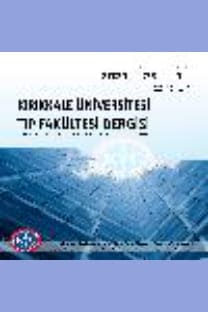Gebelik Kaybında Kromozom Analizinin Zorlukları: 1208 örnek deneyiminden çıkarılan dersler
Karyotipleme, habituel abortus, spontan abortus, anne yaşı, kromozom anomalisi.
CHALLENGES FOR CHROMOSOME ANALYSIS IN PREGNANCY LOSS: LESSONS LEARNED FROM 1208 SAMPLE EXPERIENCE
Karyotyping, habitual abortion, spontaneous abortion, maternal age, chromosomal aberrations,
___
- Stephenson M, Kutteh W. Evaluation and management of recurrent early pregnancy loss. Clin Obstet Gynecol. 2007;50(1):132-45.
- Gardner, RJ MKinlay; Sutherland, Grant R.; Shaffer, Lisa G. Chromosome abnormalities and genetic counseling. OUP USA, 2011.
- ESHRE Guideline Group on RPL, Bender Atik R, Christiansen OB, Elson J, Kolte AM, Lewis S, et al. ESHRE guideline: recurrent pregnancy loss. Hum Reprod Open. 2018;6(2):hoy004.
- Hassold T, Hunt P. To err (meiotically) is human: the genesis of human aneuploidy. Nat Rev Genet. 2001;2(4):280-91.
- Warburton D: Cytogenetics of reproductive wastage: from conception to birth, in Mark HFL (ed): Medical Cytogenetics, pp 213–246 (Marcel Dekker, New York 2000).
- Boue J, Bou A, Lazar P. Retrospective and prospective epidemiological studies of 1500 karyotyped spontaneous human abortions. Teratology 1975;12(1):11–26.
- Hassold T, Chen N, Funkhouser J, Jooss T, Manuel B, Matsuura J. et al. A cytogenetic study of 1000 spontaneous abortions. Ann Hum Genet. 1980;44(2):151–78.
- Dejmek J, Vojtassak J, Malova J. Cytogenetic analysis of 1508 spontaneous abortions originating from south Slovakia. Eur J Obstet Gynecol Reprod Biol. 1992;46(2-3):129–36.
- Gug C, Rațiu A, Navolan D, Drăgan I, Groza IM, Papurica M. et al. Incidence and spectrum of chromosome abnormalities in miscarriage samples: A retrospective study of 330 cases. Cytogenet Genome Res. 2019;158(4):171-83.
- Ozawa N, Ogawa K, Sasaki A, Mitsui M, Wada S, Sago H. Maternal age, history of miscarriage, and embryonic/fetal size are associated with cytogenetic results of spontaneous early miscarriages. J Assist Reprod Genet. 2019;36(4):749-57.
- Hardy K, Hardy PJ, Jacobs PA, Lewallen K, Hassold TJ. Temporal changes in chromosome abnormalities in human spontaneous abortions: Results of 40 years of analysis. Am J Med Genet A. 2016;170(10):2671-80.
- Zhang T, Sun Y, Chen Z, Li T. Traditional and molecular chromosomal abnormality analysis of products of conception in spontaneous and recurrent miscarriage. BJOG. 2018;125(4):414-20.
- Menasha J, Levy B, Hirschhorn K, Kardon NB. Incidence and spectrum of chromosome abnormalities in spontaneous abortions: new insights from a 12-year study. Genet Med. 2005;7(4):251-63.
- Ökten G, Kara N, Tural Ş, Güneş S, Güven D, Koçak I et al. Düşük örneklerinde sitogenetik analiz sonuçları. J. Exp. Clin. Med. 2012;29:113-5.
- Ogasawara M, Aoki K, Okada S, Suzumori K. Embryonic karyotype of abortuses in relation to the number of previous miscarriages. Fertil Steril. 2000;73(2):300-4.
- Donaghue C, Davies N, Ahn JW, Thomas H, Ogilvie CM, Mann K: Efficient and cost-effective genetic analysis of products of conception and fetal tissues using a QF-PCR/array CGH strategy; five years of data. Mol Cytogenet. 2017;10:12.
- Teles TM, Paula CM, Ramos MG, Costa HB, Andrade CR, Coxir SA et al: Frequency of chromosomal abnormalities in products of conception. Rev Bras Ginecol Obstet. 2017;39(3):110-4.
- Schaeffer AJ, Chung J, Heretis K, Wong A, Ledbetter DH, Martin CL: Comparative genomic hybridization-array analysis enhances the detection of aneuploidies and submicroscopic imbalances in spontaneous miscarriages. Am J Hum Genet. 2004;74(6):1168-74.
- Robberecht C, Schuddinck V, Fryns JP, Vermeesch JR: Diagnosis of miscarriages by molecular karyotyping: benefits and pitfalls. Genet Med. 2009;11(9):646–54.
- Berkay EG, Basaran S. New approaches to explaining the etiology in recurrent pregnancy losses. J Ist Faculty Med. 2021;84(1):135-44.
- ISSN: 2148-9645
- Yayın Aralığı: Yılda 3 Sayı
- Başlangıç: 1999
- Yayıncı: KIRIKKALE ÜNİVERSİTESİ KÜTÜPHANE VE DOKÜMANTASYON BAŞKANLIĞI
Serap KİRKİZ, Özlem ARMAN BİLİR, Fatih Mehmet AZIK, Çiğdem SÖNMEZ, Hüsniye Neşe YARALI
Gebelik Kaybında Kromozom Analizinin Zorlukları: 1208 örnek deneyiminden çıkarılan dersler
Pelin ÖZYAVUZ ÇUBUK, Fatma Nihal ÖZTÜRK, Tuğba AKIN DUMAN
ÜNİVERSİTE ÖĞRENCİLERİNİN E-ÖĞRENMEYE YÖNELİK TUTUMLARININ BELİRLENMESİ
Zeynep KİSECİK ŞENGÜL, Ali YILMAZ, Yurdagül ERDEM
SAĞLIK ÇALIŞANLARIN COVID-19 HAKKINDAKİ GÜNCEL BİLGİ VE FARKINDALIK DÜZEYLERİ
YENİDOĞAN YOĞUN BAKIM ÜNİTESİNDE YATAN HASTALARDA İNFLAMATUAR BELİRTEÇLERİN TANI VE PROGNOZDAKİ YERİ
Nagihan Akıcı KARA, Nilufer GUZOGLU, Didem ALİEFENDİOĞLU
Hüseyin Fatih SEVİNÇ, Serhat DURUSOY, Veli Çağlar ÖZ, Recep Doğan İLHAN, Ömer PIÇAKÇI, Abdurrahman ÖRTÜCÜ, Ramazan İlter ÖZTÜRK
